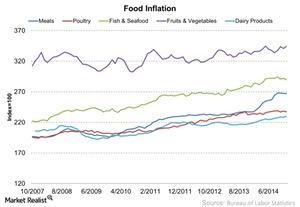How Food Inflation Impacts The Restaurant Industry
Food inflation can squeeze a restaurant’s operating margins, but a restaurant can adjust the menu pricing and pass the cost on to customers.
Nov. 20 2020, Updated 2:56 p.m. ET

Food inflation
The cost of food is one of the most important operating costs for a restaurant. In the article on McDonald’s Corporation’s major operational costs, we learned that food and paper costs make up 34% of the company’s expenses. Food inflation can squeeze a restaurant’s operating margins, but a restaurant can adjust menu pricing and pass the cost on to customers.
Food price indices
In December 2014, the price index for meat stood at 267 compared to 267.3 for the previous month. This index has been increasing sharply since the beginning of 2014.
The December poultry price index was at 237.3 compared to 238.4 for November. The fish and seafood price index stood at 289.6 compared to 291.8 for the month before. The dairy products price index was at 229.9 compared to 228.4 in November.
Meat prices saw a sharp rise towards the end of 2013 due to a hit on the supply side. According to the USDA (US Department of Agriculture), a lower number of cattle herds and a dry spell in Texas caused a beef product supply shortage. The USDA further stated that beef prices would remain higher because of the time it takes for cattle herds to be ready for the slaughter.
Rising costs for key items like beef will affect McDonald’s (MCD), Darden Restaurants (DRI), Wendy’s (WEN), Chipotle Mexican Grill (CMG), and other restaurant companies included in the Consumer Discretionary Select Sector SPDR ETF (XLY).
Recently, gasoline prices have been falling significantly. This is positive for restaurants from a supply and demand perspective. We will look at this more closely in the next article.
